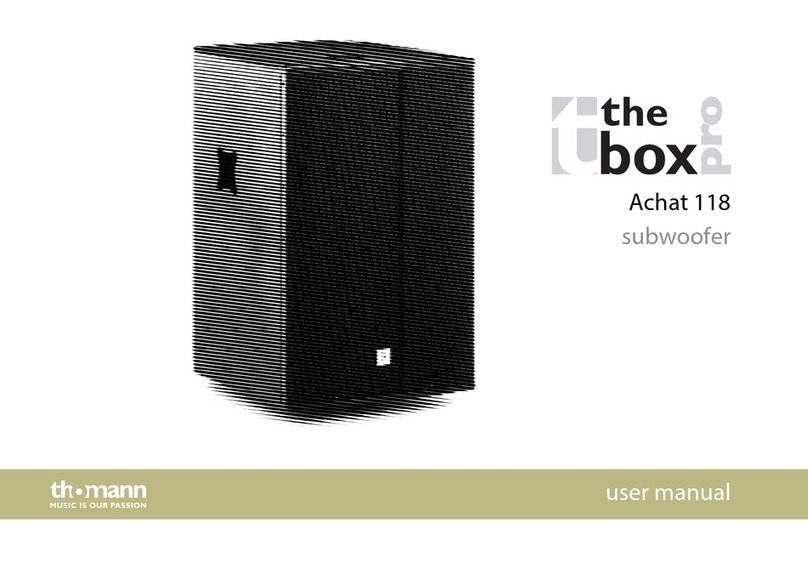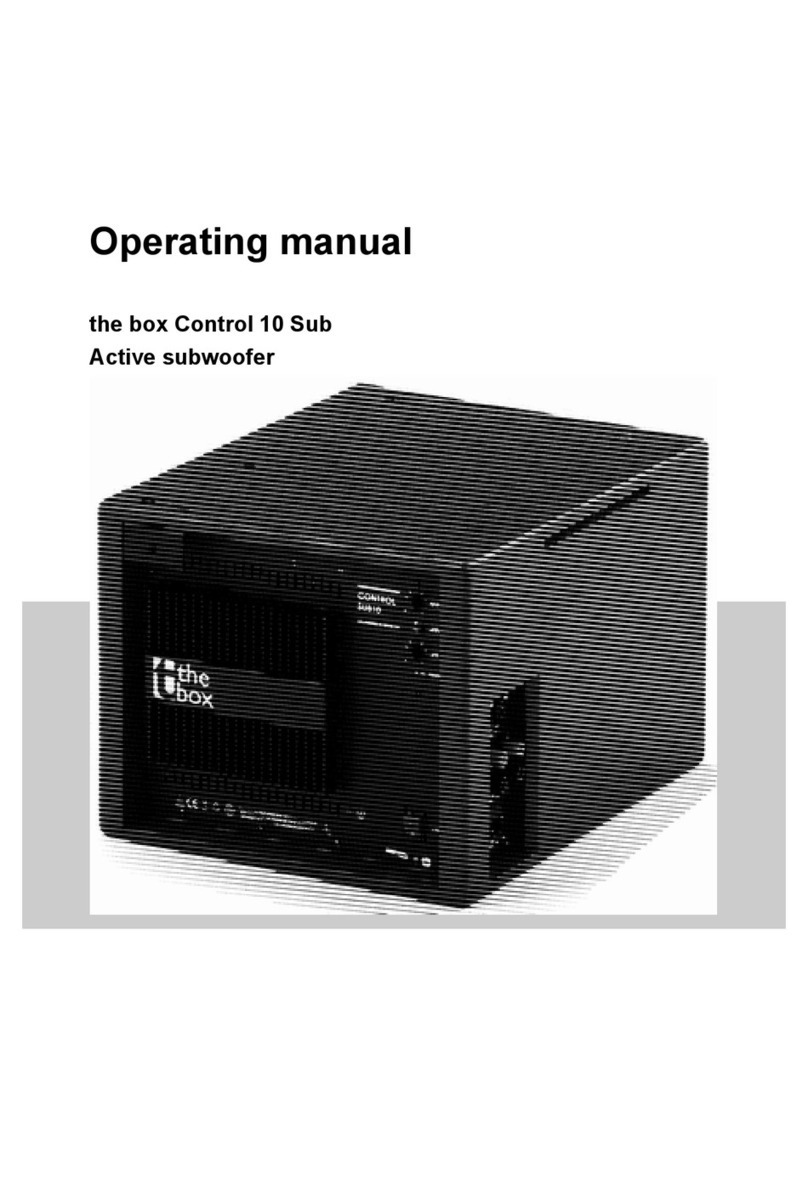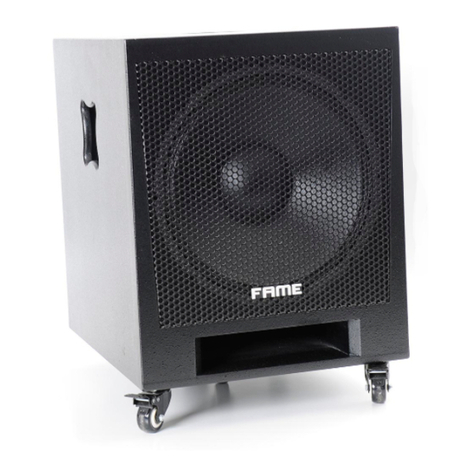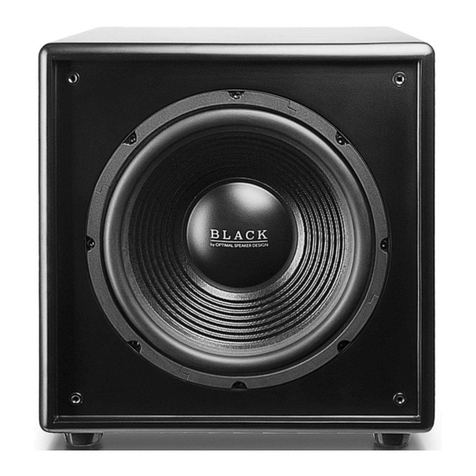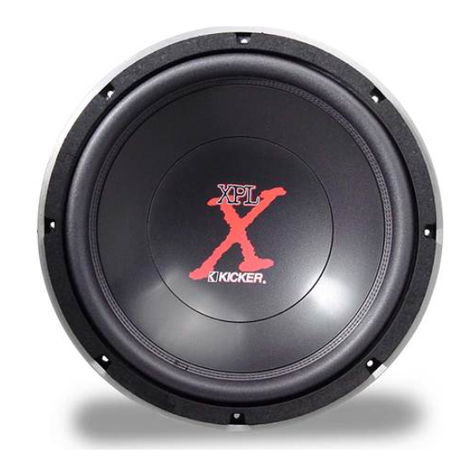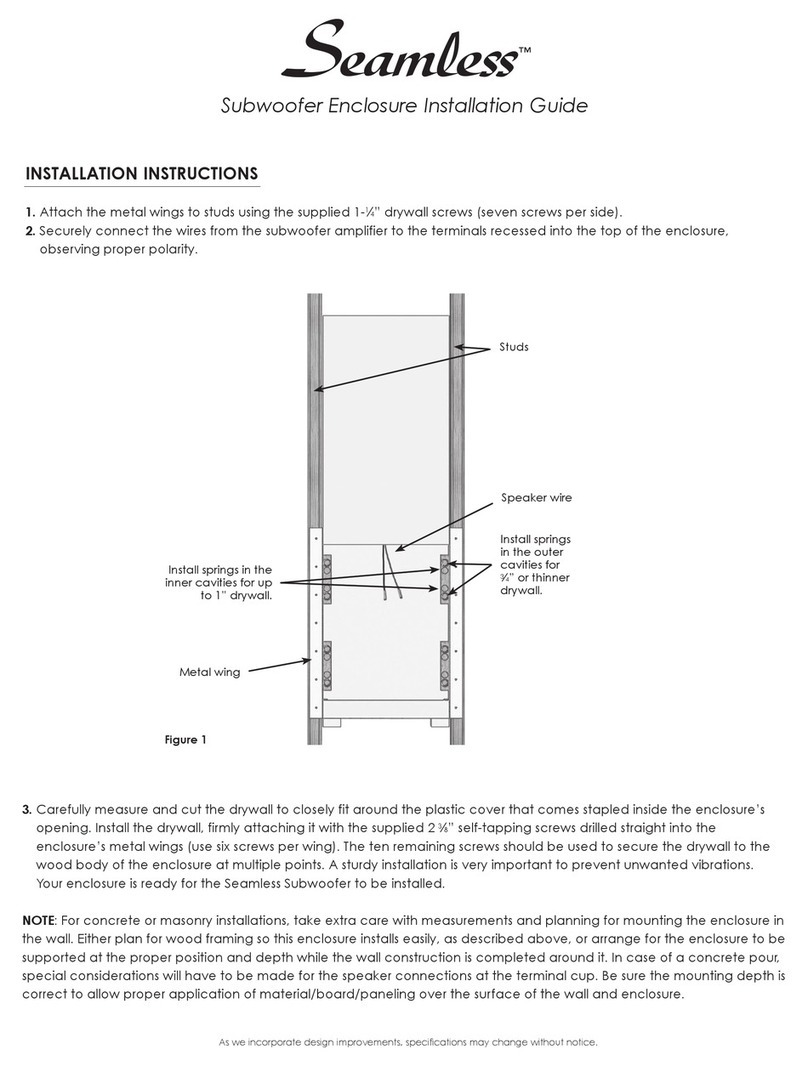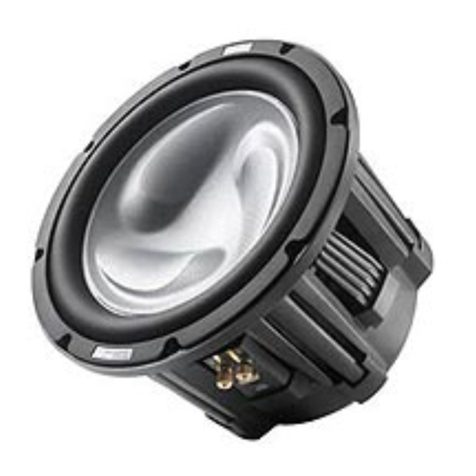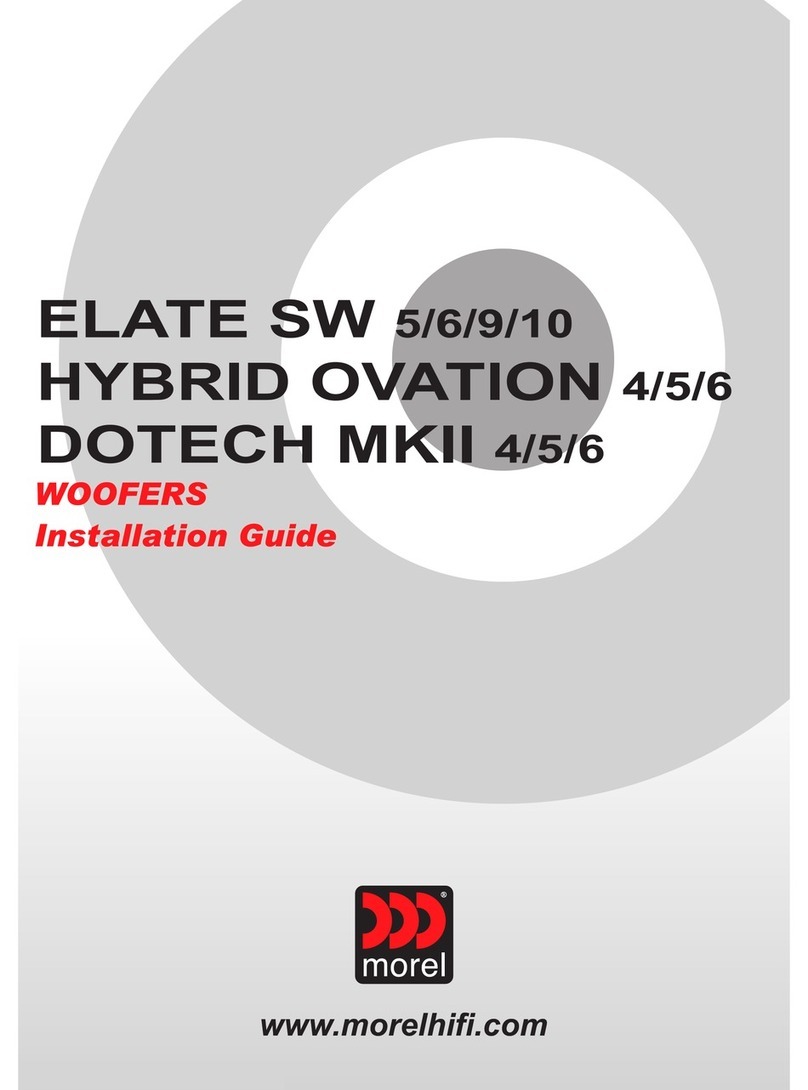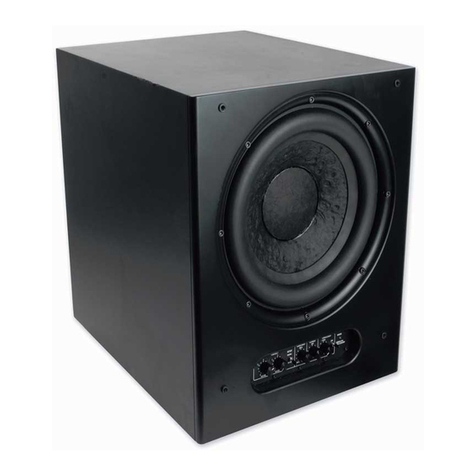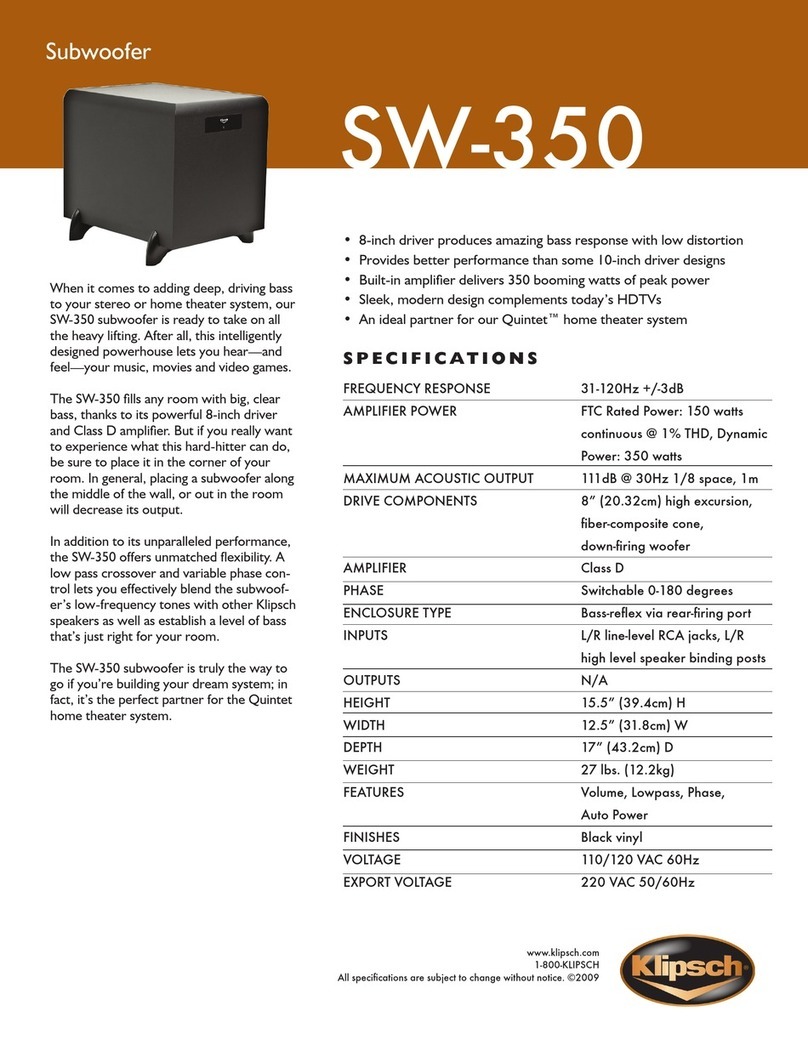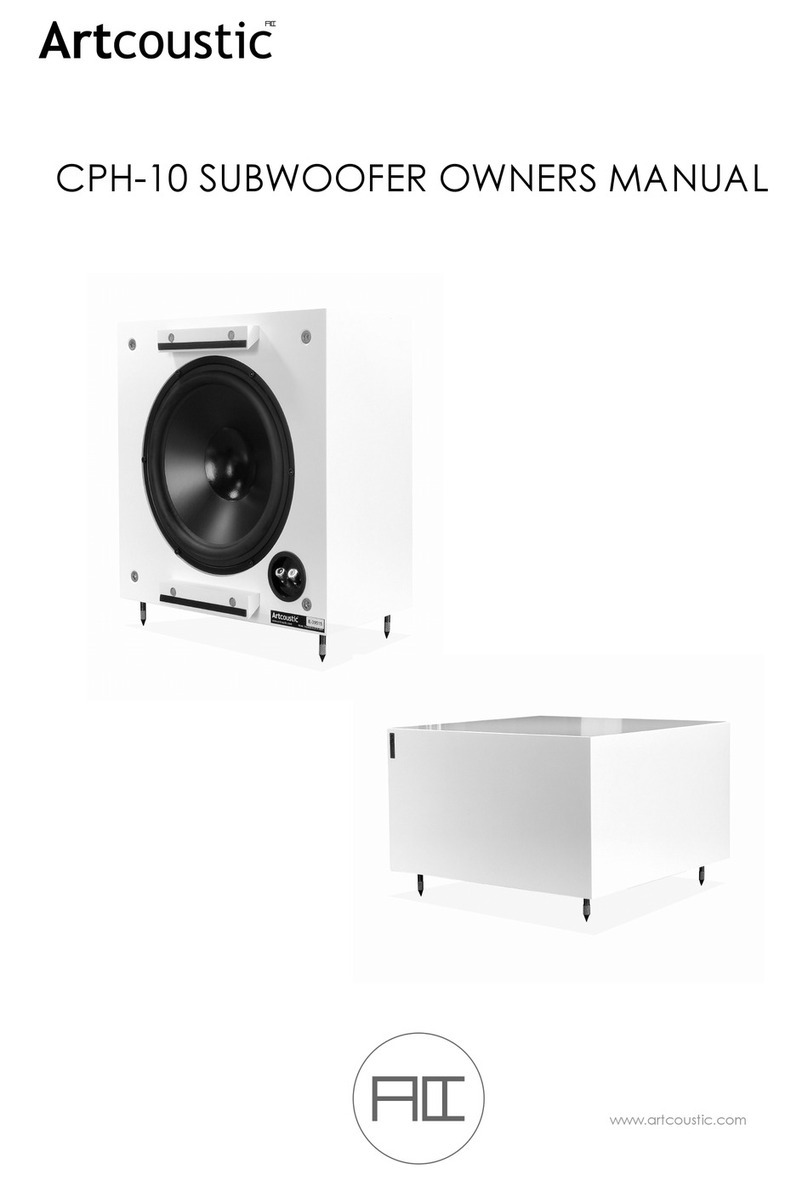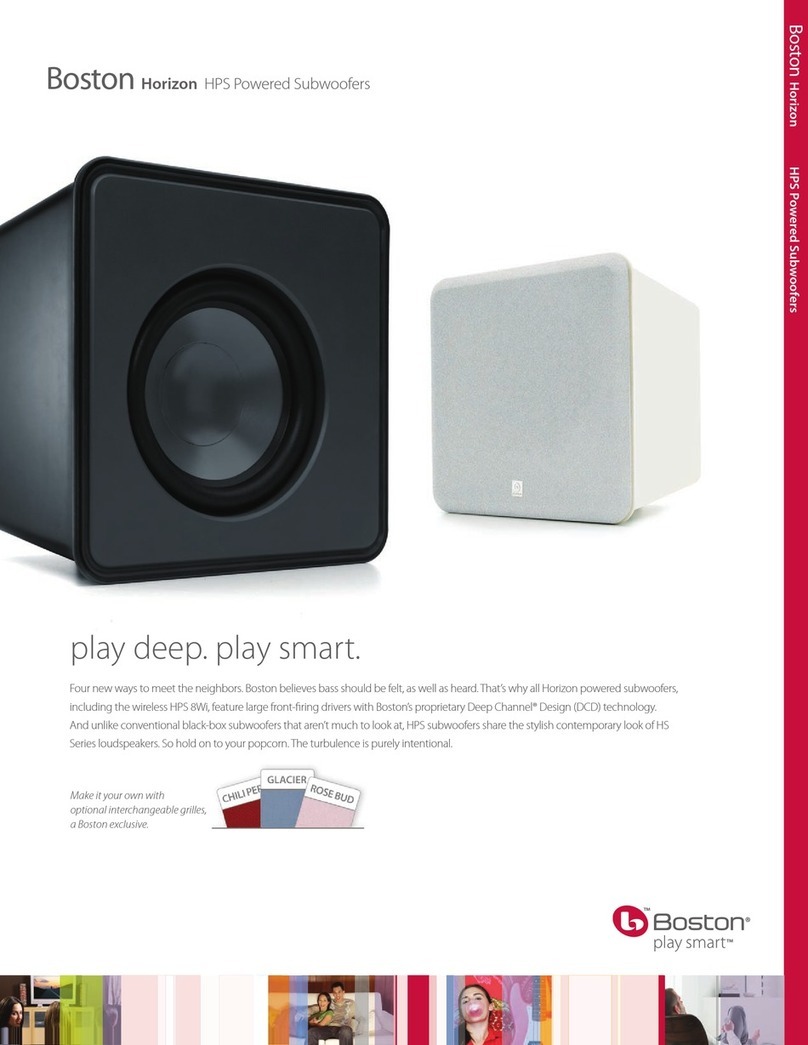Montarbo TANK12SA User manual

active subwoofer
Manuale istruzioni Instruction manual Bedienungsanleitung Manuel d'instructions Manual de instrucciones

active subwoofer
__________________________________________
__________________________________________
__________________________________________
__________________________________________
__________________________________________
__________________________________________
__________________________________________
__________________________________________
__________________________________________
__________________________________________
__________________________________________
INDICE
Introduzione
Descrizione
Pannello controlli e connessioni
Esempi di collegamento
Importante !!!
Appendix
◗
Dati tecnici
◗
Connettori
◗
Esempi di collegamento
◗
Parti di ricambio
3
3
4
5 - 6
7 - 9
26 - 29
26
26
27 - 28
29
ITALIANO
Il lampo con la freccia inserito in un triangolo equilatero avvisa l'utilizzatore della presenza
di tensione pericolosa, senza isolamento, all'interno dell'apparecchio che potrebbe essere
sufficientemente alta da generare il rischio di scossa elettrica.
Il punto esclamativo inserito in un triangolo equilatero avvisa l'utilizzatore della presenza di
importanti istruzioni per l'utilizzo e per la manutenzione del prodotto.
CONTENUTO DELL’ IMBALLO
◗Subwoofer attivo
◗Cavo di alimentazione
◗Manuale istruzioni
◗Certificato di garanzia
◗Dichiarazione di conformità CE
IMPORTANTE ! Norme di sicurezza
ATTENZIONE
Nell'interesse della propria e della altrui sicurezza, e per non
invalidare la garanzia, si raccomanda una attenta lettura di questa
sezione prima di adoperare il prodotto.
-Questo apparecchio è stato progettato e costruito per venire utilizzato come
sistema di altoparlanti con amplificatore nel contesto tipico di un sistema di
amplificazione sonora e/o di un sistema di registrazione sonora. L'utilizzo per
scopi diversi da questi non è contemplato dal costruttore, ed avviene pertanto
sotto la diretta responsabilità dell'utilizzatore/installatore.
- Questo apparecchio è conforme alla Classe di isolamento I (è necessario il
collegamento alla terra di protezione).
PER EVITARE IL RISCHIO DI INCENDIO E/O DI FOLGORAZIONE:
•Non esporre il prodotto alla pioggia, non utilizzarlo in presenza di elevata
umidità o vicino all'acqua. Non lasciare penetrare all'interno dell'apparecchio
alcun liquido, né alcun oggetto solido. In caso ciò avvenga, scollegare
immediatamente l'apparecchio dalla rete elettrica e rivolgersi ad un servizio di
assistenza qualificato prima di adoperarlo nuovamente. Non appoggiare candele
accese od altre sorgenti di fiamma nuda sopra l'apparecchio.
•Prima di collegare l'apparecchio alla rete elettrica assicurarsi che la tensione
corrisponda a quella indicata sull'apparecchio stesso.
•Collegare questo apparecchio esclusivamente ad una presa di corrente dotata
di contatto di terra, rispondente alle norme di sicurezza vigenti, tramite il cavo
di alimentazione in dotazione. Nel caso in cui il cavo necessiti di sostituzione,
utilizzare esclusivamente un cavo di identiche caratteristiche.
•L'apparecchio è collegato alla rete anche quando l'interruttore di rete è in
posizione '0' (spento) e la spia luminosa è spenta. All'interno sono presenti
potenziali elettrici pericolosi. Prima di qualunque intervento di manutenzione,
scollegare il cavo di alimentazione dalla presa di rete.
•Non appoggiare alcun oggetto sul cavo di alimentazione. Non posarlo dove
possa costituire intralcio e causare inciampo. Non schiacciarlo e non calpestarlo.
•Installare questo apparecchio prevedendo ampio spazio circostante per
un'abbondante circolazione d'aria, necessaria al raffreddamento. Non ostruire le
aperture o le prese d'aria presenti sull'apparecchio. Lasciare spazio sufficiente per
accedere alla presa di alimentazione elettrica e al connettore di rete sul pannello
posteriore.
•In caso di sostituzione del fusibile esterno, utilizzare esclusivamente un fusibile
di caratteristiche identiche, come riportato sull'apparecchio.
•Prima di effettuare qualsiasi operazione di collegamento, assicurarsi che
l'interruttore di accensione dell'apparecchio sia in posizione '0'.
•Prima di effettuare qualsiasi spostamento del prodotto già installato o in
funzione, rimuovere tutti i cavi di collegamento.
•Per scollegare l'apparecchio dalla rete elettrica, non tirare mai lungo il cavo,
ma afferrarlo sempre per il connettore.
ATTENZIONE!
Questo apparecchio non contiene parti interne destinate all'intervento
diretto da parte dell'utilizzatore. Per evitare il rischio di incendio e/o
folgorazione, non smontarlo e non rimuovere il pannello posteriore.
Per qualsiasi intervento di manutenzione o riparazione, rivolgetevi alla
Elettronica Montarbo srl e/o a personale altamente qualificato
specificamente segnalato da questa.
-Nel predisporre l'apparecchio all'utilizzo, assicurarsi che la forma e la portata
della superficie di appoggio siano idonee a sostenerlo.
Non tentare mai di appendere il prodotto con mezzi non espressamente forniti
o approvati dal costruttore (corde, catene, funi o qualsivoglia altro mezzo,
attraverso maniglie, bulloni, ganci etc.).
Nel caso il prodotto sia dotato già dalla fabbrica di specifici accessori, verificare
sempre, prima dell'installazione, che il sistema di sollevamento e/o di sospensione
che intendete utilizzare sia di portata idonea al peso del prodotto, in conformità
con le normative vigenti.
-Per evitare urti, calci, inciampi, riservate come luogo per l'istallazione del
prodotto un'area protetta inaccessibile a personale non qualificato.
Qualora l'apparecchio venga utilizzato in presenza di bambini e animali, si rende
necessaria una strettissima sorveglianza.
-Questo prodotto è in grado di generare pressioni acustiche molto elevate,
pericolose per la salute del sistema uditivo. Evitarne quindi l'utilizzo ad elevati
livelli acustici se il pubblico si trova eccessivamente vicino al prodotto.
Non esporre i bambini a forti sorgenti sonore.
2
ITALIANO

active subwoofer
3
ITALIANO
Descrizione
ACabinet in multistrato di betulla da 15 mm rifinito con vernice
anti-abrasioni
BWoofer ad alta efficienza da 12"con bobina da 2,5" e magnete
al neodimio, schermato, superventilato.
CGriglia di protezione in acciaio.
DTubi di accordo.
EManiglia laterale per il trasporto.
FPannello controlli e connessioni.
GFlangia per sostenere il sistema satellite tramite asta di raccordo
(optional) mod. SM4.
I materiali e la costruzione rispettano i più alti standard professionali
per assicurare la massima affidabilità.
D
EF
A
B
G
C
Introduzione
TANK12SA è un bass-cabinet che si distingue per le dimensioni
estremamente compatte ed il peso ridottissimo.
TANK12SA è in grado di erogare senza distorsione e con
grande accuratezza e nitidezza tutta la potenza (500 W EIAJ)
dell'amplificatore incorporato, mantenendo questa pulizia di
suono anche a livelli elevatissimi di pressione sonora.
L'amplificatore di potenza in classe D, con alimentazione
switching, è pilotato da un crossover elettronico stereo che
incorpora un limiter allo stato dell'arte, e la qualità sonora
ottenuta è senza compromessi.
Il condotto del reflex, a profilo conico, è frutto di ricerche
avanzate di fluidodinamica e permette di non avere turbo-
lenze, creando così un incremento dell'energia acustica nella
gamma di frequenze corrispondenti all'accordo del cabinet.
Tutto questo permette di ottenere altissime pressioni sonore
in un cabinet robusto e leggero da trasportare.
La grande qualità e affidabilità lo rendono un oggetto
versatile sia per il palco che nei club, per la band, il drum-fill
e il dj-set.
LINK
R
L
X-OVER
LINK X-OVER VOL.
X-OVER
AC LINE INAC LOOP OUT
PHASE
X-OVER 100Hz
POWER
Internal Fuse
I
0
180°
0°
IN
IN
230V 50-60Hz 5AIMAX 15A

active subwoofer
LINK
R
L
X-OVER
LINK X-OVER VOL.
X-OVER
AC LINE INAC LOOP OUT
PHASE
X-OVER 100Hz
24dB/oct
12dB/oct
POWER
Internal Fuse
I
0
180°
0°
IN
IN
230V 50-60Hz 5AIMAX 15A
4
1Selettore X-OVER (24dB / 12dB). Consente di selezionare la penden-
za del filtro X-OVER interno. La frequenza di taglio del filtro, del tipo
Linkwitz-Riley, è sempre a 100 Hz.
☞Pulsante sollevato: la pendenza è 24dB/oct.
☞Pulsante premuto: la pendenza è 12dB/oct.
2X-OVER: connettori XLR maschio bilanciati per l'uscita del cross-over.
3IN: prese XLR per l’ingresso stereo bilanciato (consente il collegamen-
to al mixer).
4LINK: connettori XLR maschio bilanciati, in parallelo, per il collega-
mento in parallelo di altre casse amplificate.
Vedere i connettori e gli esempi di collegamento.
5VOLUME: controllo livello ingresso. Consente di regolare la sensibilità
di ingresso del finale di potenza incorporato. Impostando il controllo al
massimo la sensibilità di ingresso è +3dBu (stereo), 9dBu (mono).
6PHASE REVERSE: invertitore di fase. Consente di compensare
agevolmente eventuali cancellazioni di fase dovute alla presenza di più
subwoofer o all'uso di satelliti con fase non standard.
Vedere 'Fase' a pagina 9.
7AC LINE IN: connettore di ingresso alimentazione.
Connettore PowerCon®tipo A (di colore blu), che garantisce un contat-
to affidabile anche in presenza di forti vibrazioni. Collegarlo alla presa
di alimentazione utilizzando solamente il cavo di alimentazione fornito
in dotazione o un cavo di alimentazione dotato di conduttore di terra
e riportante i marchi di sicurezza applicabili nel paese di impiego, con
conduttori di sezione adeguata alla corrente assorbita e spina di
Neutrik PowerCon®è un marchio Neutrik
Pannello controlli e connessioni
34
ITALIANO
alimentazione certificata per questo valore di corrente.
Per le istruzioni di cablaggio del connettore, fare riferimento a pag. 8.
Nell'installazione del diffusore, accertarsi che sia possibile accedere
facilmente a questo connettore e alla presa di alimentazione elettrica.
8AC LOOP OUT: connettore di uscita alimentazione.
Connettore PowerCon®tipo B (di colore grigio) che permette il
collegamento (link) alla rete elettrica di altre apparecchiature
(max. 15A disponibili).
Per le istruzioni di cablaggio del connettore, fare riferimento a pag. 8.
ATTENZIONE: la corrente massima che il connettore di alimentazione
PowerCon 'AC LINE IN' (7) può trasportare è pari a 20A. La corrente
massima che può essere fornita dal connettore 'AC LOOP OUT' (8)
è pari a 15A. Nel caso venga utilizzato il connettore 'AC LOOP OUT'
(8) per alimentare altre apparecchiature, è responsabilità dell'utente
verificare che:
- questo valore massimo di assorbimento non sia superato,
- l'assemblaggio del cordone di rete sia effettuato da personale
specializzato seguendo le regole impiantistiche nazionali.
9Interruttore di rete. Anche se è in posizione 0 (spento) il connettore
'AC LOOP OUT' è sempre sotto tensione.
Le eventuali altre apparecchiature ad esso collegate devono essere
spente agendo sui rispettivi interruttori di rete.
2 5 6
1
9
8
7

active subwoofer
Esempi di collegamento
Esempio B:
2TANK12SA + 2casse autoamplificate
É l'esempio di utilizzazione più classico, dove ogni subwoofer pilota
una cassa acustica autoamplificata.
uscite L / R del mixer ➟ingressi 'R' dei 2 subwoofer
uscite 'x-over' R dei 2 subwoofer ➟ingressi delle 2 casse attive
uscita LINK 'R' di ogni subwoofer ➟ingresso IN 'L' di ogni subwoofer
Vedere esempio di collegamento 'B'
•Collegare le uscite L ed R del mixer agli ingressi (3) 'R' dei
due subwoofer.
•Collegare le uscite X-OVER 'R' (2) dei due subwoofer agli ingressi
delle due casse attive.
•Il controllo 'VOLUME' (6) del subwoofer non regola il volume delle
casse acustiche satellite.
Esempio C:
1TANK12SA + 2casse autoamplificate
Questa utilizzazione è più complessa, ma consente di rinforzare
selettivamente le basse frequenze (ad esempio, solo per le percussioni e
le tastiere e non per i fiati e le voci).
Nota: É consigliabile posizionare il subwoofer al centro rispetto alle casse.
uscita 'AUX' del mixer ➟ingresso 'R' di un subwoofer
uscite L / R del mixer ➟ingressi delle 2 casse attive
Vedere esempio di collegamento 'C'
• Collegare una uscita AUSILIARIA (AUX) del mixer
all'ingresso (3) 'R' del subwoofer.
• Collegare le uscite L ed R del mixer agli ingressi delle casse attive.
•Per selezionare gli strumenti da inviare al subwoofer usare i controlli
di mandata AUX dei corrispondenti canali di ingresso. Il controllo di
volume del subwoofer e quello dell’uscita AUX del mixer regolano solo
le basse frequenze.
Esempio D: collegamento in parallelo di due o più
subwoofer
TANK12SA
uscite L / R del mixer ➟ingressi L / R del primo subwoofer
uscite LINK L / R del primo subwoofer ➟ingressi L / R del secondo
subwoofer
Vedere esempio 'D'
• Collegare le uscite L ed R del mixer agli ingressi (3) L ed R
del subwoofer.
• Collegare le uscite LINK (4) L ed R del primo subwoofer
agli ingressi (3) L ed R del secondo subwoofer.
L’omnidirezionalità delle bassissime frequenze riprodotte dal subwoofer
Tank12SA rende la sua installazione per nulla critica. È sempre preferibile
posizionare il subwoofer vicino alle casse acustiche, ma quando
necessità di spazio o praticità di montaggio lo richiedano il subwoofer
può essere montato anche a distanza dalle casse stesse (ad esempio:
sotto palco, centro palco). Occorre tenere sempre presente che il rischio
di rientri acustici (feedback), con conseguenti inneschi o 'code' indesi-
derate, aumenta a causa della maggiore estensione della risposta in
frequenza. É quindi importante prestare attenzione ed installare il sub-
woofer su strutture rigide, che non trasmettano vibrazioni ai microfoni.
La sensibilità di ingresso del subwoofer TANK12SA è +3dBu, quando
sono collegati entrambi gli ingressi (L + R). Se si collega un solo ingresso
la sensibilità si dimezza (+9dBu). Quando si vuole utilizzare un
TANK12SA con 1 cassa satellite con sensibilità standard (+3dBu) si
consiglia, per evitare differenze di resa tra sub e cassa, di collegare
l'uscita del mixer all'ingresso IN 'R' del subwoofer e di pilotare anche
l'ingresso IN 'L' collegandolo all'uscita LINK 'R', dello stesso subwoofer,
con un cavo XLR bilanciato. In tal modo la sensibilità di ingresso del
subwoofer viene aumentata a +3dBu
Descriviamo qui di seguito alcune tra le configurazioni possibili
più comuni, che troverete illustrate alle pagine 27 e 28.
Utilizzare sempre cavi schermati di adeguata sezione e di buona
qualità.
Esempio A:
1TANK12SA + 2casse autoamplificate
L'uscita stereo del crossover incorporato semplifica al massimo questo
tipo di collegamento, solitamente molto più complesso in altri sistemi.
Nota: É consigliabile posizionare il subwoofer al centro rispetto alle casse.
Questo set-up permette di beneficiare di un incremento della
dinamica fornita dal crossover elettronico presente nel subwoofer.
uscite L / R del mixer ➟ingressi L / R del subwoofer
uscite 'x-over' L / R del subwoofer ➟ingressi delle 2 casse attive
Vedere esempio di collegamento 'A'
•Collegare le uscite L ed R del mixer agli ingressi (3) L ed R del
subwoofer.
•Collegare le uscite X-OVER (2) L ed R del subwoofer agli
ingressi delle due casse attive.
•Il controllo 'VOLUME' (6) del subwoofer non regola il volume delle
casse acustiche satellite.
5
ITALIANO

active subwoofer
6
ITALIANO
Collegamento al mixer
•Utilizzare sempre solo cavi SCHERMATI (cavi di segnale) di adeguata
sezione e di buona qualità.
•Prima di effettuare i collegamenti con il mixer, con i satelliti o con
qualsiasi altro sistema accertarsi che tutti gli interruttori di rete siano
in posizione 'off'. In tal modo si eviteranno fastidiosi rumori e picchi di
segnale talvolta pericolosi per le casse stesse.
Se il mixer ha uscite bilanciate XLR: utilizzare dei normali connettori
XLR bilanciati.
Se il mixer ha uscite sbilanciate XLR e non è Montarbo: è bene
accertarsi che le uscite XLR del mixer siano sbilanciate a norme
IEC 268 e cioé: 1 = massa (GND), 2 = caldo (HOT), 3 = massa (GND).
Se il mixer ha uscite JACK bilanciate (Jack stereo): utilizzare adatta-
tori Jack stereo-XLR bilanciati, a norme IEC 268 e cioé: pin 1 = massa,
pin 2 = punta, pin 3 = anello.
Se il mixer ha uscite JACK sbilanciate: utilizzare adattatori Jack-XLR
maschio sbilanciati a norme IEC 268 e cioé: pin 1 = massa,
pin 2 = punta, pin 3 = massa.
Vedere connettori.
Esempi di collegamento
Nota:
se disponete di un mixer amplificato provvisto di prese insert
sulle uscite master L-R, e volete utilizzare il subwoofer senza
escludere le uscite di potenza, potete prelevare il segnale dalle stesse
prese insert mediante jack stereo, nei quali avrete precedentemente
collegato l'anello (RING) con la punta (TIP) cortocircuitandoli, ed
inviarlo agli ingressi del subwoofer mediante XLR (vedi figura).
tip ring sleeve
(GND)
PRESA INSERT
MIXER JACK STEREO XLR MASCHIO
PRESA XLR SUBWOOFER
IN
IN
anellopunta massa
1
2
3

active subwoofer
Importante !
Inserimento Disinserimento
Cablaggio del cavo di alimentazione sul connettore
PowerCon
®
(fornito con l'apparecchio).
L'assemblaggio del cordone di rete deve essere effettuato da personale
specializzato seguendo le regole impiantistiche nazionali.
Spelare il cavo per una lunghezza di 20 mm ed ogni singolo filo per una
lunghezza di 8 mm. Consigliamo l'utilizzo di un cavo di alimentazione
con conduttori aventi sezione di almeno 2,5 mm
2
(i morsetti dell'in-
serto possono comunque portare un cavo con fili aventi sezione fino a
4mm
2
/12AWG).
Infilare il cavo prima nella bussola poi nel serracavo (bianco per un cavo
con diametro 5÷11mm; nero per un cavo con diametro 9.50 ÷ 15mm).
Effettuare i collegamenti dei conduttori ai morsetti dell'inserto.
I conduttori potranno essere serrati nei morsetti oppure saldati, facendo
però sempre attenzione ai simboli che compaiono sul connettore stesso:
L (Line - corrispondente al filo di colore marrone),
N (Neutro - corrispondente al filo di colore azzurro) e
(Terra - corrispondente al filo di colore giallo e verde).
Effettuati i collegamenti dei fili sull'inserto infilare il cavo nel corpo e
avvitare quest'ultimo alla bussola utilizzando una chiave da 3/4"con
una coppia di serraggio minima pari a 2,5Nm.
Il cavo utilizzato per il cablaggio deve essere conforme alle normative
vigenti nel paese di utilizzo. La sezione minima dei conduttori è:
2,5mm
2
per cavo collegato al connettore NC3 MPA (AC Line In);
1,5mm
2
per cavo collegato al connettore NC3 MPB (AC Loop Out).
La spina di corrente sul lato opposto deve essere certificato per una
corrente pari almeno a 20A (es: IEC309 32 A).
Quando, per qualunque motivo, il cavo di alimentazione risulta danneg-
giato, occorre provvedere alla sua riparazione prima di riutilizzarlo.
Per la sostituzione del cavo:
1 - scollegare il cavo completamente
2 - svitare la bussola (chiave 3/4")
3 - mediante cacciavite, scollegare i 3 conduttori dal connettore.
4 - rimuovere serracavo e bussola dal cavo
5 - utilizzando un nuovo cavo conforme ai requisiti indicati, procedere
al montaggio del connettore (vedi sopra)
ATTENZIONE:
- Prima di collegare e/o scollegare il connettore Powercon, è necessario
spegnere tutte le apparecchiature alle quali è collegato il cavo e
disconnettere il cavo dalla rete elettrica.
- Occorre utilizzare sempre questa procedura anche quando si procede
allo spostamento delle casse.
Per scollegare o collegare il connettore operare come indicato nel
disegno qui a lato.
c o n n e t t o r e c h i u s o
c o r p o
b u s s o l as e r r a c a v o
c a v o
m o r s e t t i
v i s t a i n t e r n a
i n s e r t o
f i l i
c a v o
f i l i
20 mm
8 mm
7
ITALIANO

active subwoofer
Cura e manutenzione del prodotto
•Evitare di esporre lecassealla radiazione solare diretta, ad eccessive
vibrazioni e ad urti violenti.
•Non porre sulla cassa sorgenti di fiamme nude, quali candele accese.
Posizionare lecasse lontano da fonti di calore (lampade, fari, sorgenti
luminose di alta potenza, caloriferi o qualsiasi altro oggetto che
produca calore).
•Evitare l’uso ed il deposito del sistema in ambienti polverosi o umidi:
si eviteranno così cattivi funzionamenti e deterioramento anticipato
delle prestazioni.
•Evitare l'uso del sistema vicino a fonti di interferenze elettromagne-
tiche (monitor video, cavi elettrici di alta potenza). Ciò potrebbe
compromettere la qualità audio.
•Nel caso in cui il sistema venga utilizzato all’aperto fare attenzione a
proteggerlo dalla pioggia.
•Proteggere l’apparecchio dal rovesciamento accidentale di liquidi o
sostanze di qualsiasi tipo. In particolare nelle condizioni di utilizzo tipi-
che, prestare la massima attenzione alla collocazione dell’apparecchio
onde evitare che il pubblico, i musicisti, i tecnici o chicchessia possa
poggiarvi sopra bicchieri, tazze, contenitori di cibo o di bevande,
posacenere o sigarette accese.
•Non rimuovere la griglia di protezione dalle casse.
•Per rimuovere la polvere usate un pennello o un soffio d’aria,
non usare mai detergenti, solventi o alcool.
•Avere cura dei cavi di collegamento, avvolgerli evitando nodi e torsioni.
•Non forzare i connettori.
•All’interno dell’apparecchio possono essere presenti potenziali elettrici
pericolosi anche quando l’interruttore di rete è in posizione '0' (spento)
e la spia luminosa è spenta. Prima di qualunque intervento di manuten-
zione, scollegare il cavo di alimentazione dalla presa di rete.
8
ITALIANO
Collegamento alla RETE
•Accertarsi che l'interruttore di rete sia in posizione '0' (spia luminosa
spenta).
•Accertarsi che la tensione di rete corrisponda a quella indicata
sul pannello.
•Collegare il cavo di alimentazione ad una presa di corrente dotata
di contatto di terra di sicura efficienza. Utilizzare solamente il cavo di
alimentazione fornito con l’apparecchio o un altro dotato di contatto di
terra e riportante i marchi di sicurezza applicabili nel paese di impiego.
•Lasciare spazio sufficiente per accedere alla presa di alimentazione
elettrica e al connettore di rete sul pannello posteriore. All’interno
dell’apparecchio possono essere presenti potenziali elettrici pericolosi
anche quando l’interruttore di rete è in posizione '0' (spento) e la spia
luminosa è spenta. Prima di qualunque intervento di manutenzione,
scollegare il cavo di alimentazione dalla presa di rete.
Importante !

active subwoofer
Fase
La fase, in un sistema di diffusione sonora, riveste un’importanza fon-
damentale. Due diffusori che emettono lo stesso programma musicale
interagiscono fra loro e possono provocare interferenze distruttive.
Ciò significa che le onde sonore prodotte dai due diffusori che arrivino
in un punto (un ascoltatore, o una parte della platea da servire) con
fase diversa (due punti diversi dell’onda) si possono combinare in modo
'errato', ed invece di produrre un’onda sonora di ampiezza maggiore
(un suono più 'forte' di quello prodotto dal singolo diffusore), ne
producono una di ampiezza minore.
Detto in altri termini, i due suoni si sottraggono anziché sommarsi.
Nella condizione peggiore, nella quale la fase dei due segnali è opposta
(sfasamento di 180°, o 'controfase') il risultato è l’annullamento del
suono. Se in un certo istante, infatti, la prima onda arriva all’ascoltat-
re col suo valore massimo (+), e la seconda arriva col suo valore minimo
(-) il risultato può essere nullo (o comunque un suono molto più debole
rispetto a quello prodotto dal singolo diffusore).
La disposizione nello spazio dell’ascoltatore e dei diffusori, il tipo di
carico acustico usato, l’ambiente ed altro (crossover, processori elettro-
nici, ecc) sono alcune fra le possibili cause di queste differenze di fase.
Il pulsante di inversione di fase (6) serve ad evitare la condizione più
drammatica(controfase), ed a limitare in molti altri casi le cancellazioni
dovute a questo fenomeno fisico. Spesso si usa questa soluzione nei
sistemi semplici, in cui non viene utilizzato un processore per la
gestione dei PA (il quale, nei sistemi più complessi, gestisce il riallinea-
mento in fase in modo molto più raffinato mediante l’introduzione di
opportuni ritardi fra le diverse vie del sistema).
Il più classico degli utilizzi è nel rifasamento fra subwoofer e satellite.
Nella regione di cross-over (100/120Hz per i sistemi Montarbo)
si potrebbe creare un 'buco' nella risposta in frequenza dovuta allo
sfasamento presente fra subwoofer e satellite (ancora una volta cau-
sato dalla disposizione nello spazio, ecc). In questo caso è sufficiente
invertire la fase del subwoofer per ridurre questo effetto indesiderato.
È fondamentale porre la massima attenzione alla fase impostata sui
diversi subwoofer. Una inversione (dovuta alla errata pressione del ta-
sto) su uno o più di essi rispetto agli altri comporta una quasi completa
cancellazione del suono prodotto.
In situazioni standard tutti i subwoofer devono avere la stessa fase
(tutti regolati su 0° o tutti su 180°).
Sensibilità e clipping. Come evitare il clipping
Ogni sistema amplificatore-altoparlante è caratterizzato da una
sensibilità di ingresso. La sensibilità è definita come il valore del segnale
di ingresso all'amplificatore che produce la massima potenza in uscita.
Aumentando il segnale oltre tale valore, infatti, non si ottiene una
maggiore potenza di uscita, ma soltanto un fenomeno di distorsione
detto 'clipping' (saturazione).
In questa situazione l'altoparlante lavora in modo improprio.
Si hanno delle sovraescursioni e una dissipazione anomala nella bobina
mobile, che si surriscalda e può rompersi.
I processori attivi possono evitare solo parzialmente il clipping,
abbassando il guadagno dell'amplificatore.
È possibile, in casi estremi, oltrepassare anche questo tipo di
protezione. Ciò che il processore non può modificare è un'onda
che arrivi già distorta in ingresso all'amplificatore.
Gli effetti di un segnale di questo tipo sono gli stessi descritti sopra.
Come evitare il clipping
Il metodo più semplice sta nel controllare i livelli della catena del
segnale. Partendo dal canale del mixer bisogna impostare i
controlli (gain ed equalizzatori) in modo tale che il VU-meter del PFL
non oltrepassi mai (o solo occasionalmente) gli 0dB o, in mixer più
semplici, che la spia 'clip' o 'peak' non si accenda mai (o solo
occasionalmente). Se si oltrepassano tali livelli occorre diminuire il gain
del canale. Una volta impostato il giusto mix, bisogna fare attenzione
ad impostare il livello di uscita in modo tale che il VU-meter non
oltrepassi mai il livello della sensibilità di ingresso della cassa amplificata
o del finale di potenza.
Nel caso del modello TANK12SA la sensibilità di ingresso è +3dBu stereo
(L + R), +9dBu quando è cablato un solo ingresso (mono) L o R.
Importante !
Attenzione !
Il prodotto è contrassegnato da questo simbolo che segnala di non smaltire le apparecchiature elettriche ed elettroniche tramite la normale procedura di smaltimento dei rifiuti domestici.
Per questi prodotti è previsto un sistema di raccolta differenziato in conformità alla legislazione che richiede il trattamento, il recupero e il riciclaggio adeguato dei suddetti prodotti.
Per maggiori informazioni si prega di contattare l’autorità locale competente.
La barra nera sotto il simbolo indica che il prodotto è stato immesso sul mercato dopo il 13 Agosto 2005.
INFORMAZIONI PER UN CORRETTO SMALTIMENTO
Per gli utenti privati - Nell’Unione europea
Attenzione: Per smaltire il presente dispositivo, non utilizzare il normale bidone della spazzatura! Le apparecchiature elettriche ed elettroniche usate devono essere gestite a parte e in conformità alla legislazione
che richiede il trattamento, il recupero e il riciclaggio adeguato dei suddetti prodotti. In seguito alle disposizioni attuate dagli Stati membri, i privati residenti nella UE possono conferire gratuitamente le apparec-
chiature elettriche ed elettroniche usate a centri di raccolta designati*. In alcuni paesi (*), anche il rivenditore locale può ritirare gratuitamente il vecchio prodotto se l’utente acquista un altro nuovo di tipologia
simile. * Per maggiori informazioni si prega di contattare l’autorità locale competente.
In paesi che non fanno parte dell’UE: contattare le autorità locali e informarsi sul metodo di smaltimento corretto. In Svizzera: Le apparecchiature elettriche o elettroniche usate possono essere restituite
gratuitamente al rivenditore, anche se non si acquista un prodotto nuovo. Altri centri di raccolta sono elencati sulle homepage di www.swico.ch o di www.sens.ch.
Per gli utenti professionali - Nell’Unione europea
Attenzione: Se il prodotto è impiegato a scopi professionali, procedere come segue per eliminarlo: contattare il proprio rivenditore Montarbo che fornirà informazioni circa il ritiro del prodotto.
Potrebbero essere addebitate le spese di ritiro e riciclaggio. Prodotti piccoli (e quantitativi ridotti) potranno essere ritirati anche dai centri di raccolta locali. In Spagna: contattare il sistema di raccolta ufficiale
o l’ente locale preposto al ritiro dei prodotti usati. In paesi che non fanno parte dell’UE: contattare le autorità locali e informarsi sul metodo di smaltimento corretto

active subwoofer
__________________________________________
__________________________________________
__________________________________________
__________________________________________
__________________________________________
__________________________________________
__________________________________________
__________________________________________
__________________________________________
__________________________________________
__________________________________________
INDEX
Introduction
Description
Control and connection panel
Connection examples
Important !!!
Appendix
◗
Specifications
◗
Connectors
◗
Connection examples
◗
Spare parts
11
11
12
13 - 14
15 - 17
26 - 29
26
26
27 - 28
29
ENGLISH
10
ENGLISH
The lighting flash with arrowhead symbol within an equilateral triangle, is intended to alert the
user to the presence of uninsulated 'dangerous voltage' within the product's enclosure, that
may be of sufficient magnitude to constitute a risk of electric shock to humans.
The exclamation point within an equilateral triangle, is intended to alert the user to the
presence of important operating and maintenance (servicing) instructions.
PACKAGE CONTENTS
◗Active subwoofer
◗Power supply cable
◗Owner’s manual
◗Warranty certificate
◗CE declaration of conformity
IMPORTANT ! SAFETY INSTRUCTIONS
WARNING
In order to protect your own and others' safety and to avoid
invalidation of the warranty of this product, please read this section
carefully before operating this product.
- This product has been designed and manufactured for being operated as an active
speaker system in the applications tipical of a sound reinforcement system or of a
sound recording system. Operation for purposes and in applications other than these
has not been covered by the manufacturer in the design of the product, and is
therefore to be undertaken at end user's and/or installer's sole risk and responsability.
- This unit conforms to Class I insulation requirements, and for safe use it is required
that the protective earth contact is connected to a grounded (earthed) outlet.
TO AVOID THE RISK OF FIRE AND/OR ELECTRIC SHOCK:
•Never expose this product to rain or moisture, never use it in proximity of water or
on a wet surface. Never let any liquid, nor any object, enter the product.
In case, immediately disconnect it from the mains supply and refer to servicing before
operating it again. Never place burning candles or other sources of open flame on
top of the device.
•Before connecting this product to the mains supply, always make sure that the
voltage on the mains outlet corresponds to that stated on the product.
•This product must be connected to a grounded mains outlet complying with the
safety regulations in force, using the supplied power cable. In case the power cable
needs to be substituted, use exclusively a cable of the same type and characteristics.
•For US and CANADA only: do not defeat the safety purpose of the grounding-type
plug. A grounding type plug has two blades and a third grounding prong. The wide
blade or the third prong are provided for your safety. When the provided plug does
not fit into your outlet, consult an electrican for replacement of the obsolete outlet.
•This device is connected to the power line even when the mains switch is in the '0'
(off) position and the power indicator is off. As long as it is plugged in there are
dangerous electrical potentials inside the device, so, before undertaking any sort of
maintenance work etc, always make sure it has been unplugged from the mains socket.
•Never place any object on the power cable. Never lay the power cable on a
walkway where one could trip over it. Never compress or pinch it.
•Never install the product without providing adequate airflow to cool it.
Never obstruct the air intake openings. Leave enough room to get to the mains
power socket and the mains connector on the back panel.
•In case the external fuse needs replacement, substitute it only with one of the same
type and rating, as stated on the product.
•Always make sure the Power switch is in its '0' (off) position before doing any work
on the connections of the product.
•Before attempting to move the product after it has been installed, remove all the
connections.
•To disconnect the power cable of this product from the mains supply never pull
the cable directly. Hold the body of the plug firmly and pull it gently from the mains
supply outlet.
CAUTION!
This product does not contain user serviceable parts.
To prevent fire and/or electrical shock, never disassemble it or remove
the rear panel. For maintenance and servicing always refer to the official
Montarbo Distributor in your Country or to qualified personnel
specifically authorised by the Distributor.
- Before placing the product on a surface of any kind, make sure that its shape and
load rating safely match the product size and weight. Never attempt to hang the
product by any means not expressly provided or approved by the manufacturer (i.e.
ropes, chains, belts or whatever medium, throgh carring handles, bolts, hooks or
whatever). In case the product is factory-fitted with specific mounting hardware,
always verify before installation that the lifting and/or hanging system you intend to
use is of a proper type and can carry the product weight with the safety ratio required
by the regulations in force.
-To avoid shocks, kicks, or whatever accidents, always set aside a protected area with
no access to unqualified personnel as an installation site for the product. If case the
product is to be used near children or animals, close supervision is necessary.
-This product can generate very high acoustic pressures which are dangerous to the
hearing system. Always avoid operation at loud levels if anyone is excessively near to
the product.
Never expose children to high sound sources.

active subwoofer
11
ENGLISH
Description
A
15mm birch multiply enclosure with anti-abrasion paint.
B
12” woofer (2.5“ voice coil) with shielded super ventilated
neodymium magnet
.
C
Perforated steel protection grid
.
D
Tuning ports
.
E
Carrying handle
.
F
Control and connection panel
.
G
Adaptor for Montarbo SM4 satellite supporting pole (optional)
.
Construction and components conform to the highest professional
standards for maximum reliability.
D
EF
A
B
G
C
Introduction
TANK12SA bass-cabinet is characterized by its unusually
compact shape and weight.
TANK12SA is capable of gearing with neutrality and accuracy
the full power (500 W EIAJ) of the internal amplifier,
reproducing a clear and undistorted sound even at very high
pressure levels. The class-D power amplifier, with switch-mode
power supply, is driven by a stereo crossover incorporating a
state-of-the-art limiter circuit, and the resulting sound quality
outclasses what is usually available from many larger
and more powerful subwoofers.
The reflex port's conical profile, result of advanced fluid
dynamics research, minimizes any turbulence effect, thus
increasing the acoustical energy in the frequency range of
the cabinet's tuning.
The result of these original design details is a sturdy cabinet,
easy to transport and capable of the highest sound pressures.
Its great quality and reliability make it a versatile device,
suitable for many environments and uses: from stage to clubs,
from the rock band to the dj-set and the drum-fill.
LINK
R
L
X-OVER
LINK X-OVER VOL.
X-OVER
AC LINE INAC LOOP OUT
PHASE
X-OVER 100Hz
POWER
Internal Fuse
I
0
180°
0°
IN
IN
230V 50-60Hz 5AIMAX 15A

active subwoofer
12
ENGLISH
LINK
R
L
X-OVER
LINK X-OVER VOL.
X-OVER
AC LINE INAC LOOP OUT
PHASE
X-OVER 100Hz
24dB/oct
12dB/oct
POWER
Internal Fuse
I
0
180°
0°
IN
IN
230V 50-60Hz 5AIMAX 15A
1X-OVER (24dB / 12dB) switch allowing the selection of the X-Over
slope. The X-Over frequency, is always set to 100 Hz. The filter is a
Linkwitz-Riley type.
☞Button up: the slope is at 24dB/oct.
☞Button down: the slope is at 12dB/oct.
2X-OVER: balanced XLR male sockets for the stereo cross-over output.
3IN: balanced XLR inputs for the connection to the mixer.
4LINK: balanced XLR male sockets ('link') for parallel connection of
active speaker systems.
See 'connectors' and 'connection examples'.
5VOLUME: input level control. Allows to set the input sensitivity of the
built-in power amplifier. Turning this control fully clockwise (to its
maximum setting) sets the input sensitivity to +3dBu (stereo), 9dBu
(mono).
6PHASE REVERSE: by means of this switch the absolute phase of the
subwoofer may be reversed, allowing for the use of satellite loudspeak-
ers with a non-standard phasing, or for multi-subwoofer installation,
thereby avoiding possible phase cancellations.
See 'Phase' on page 17.
Control and connection panel
34
7AC LINE IN: mains supply inlet socket with type A PowerCon®(blue)
connector, which guarantees a reliable, vibration-proof contact.
Use only a mains cable with suitable conductors capable of handling
the current involved, equipped with a ground conductor, marked with
the applicable, country specific, safety approvals and fitted with a
power plug certified for the actual current value.
Refer to page 14 for connector wiring instructions.
When installing make sure that it is easy to get to this socket and to
the mains plug.
8Power 'AC LOOP OUT' socket (type B gray PowerCon®connector)
that allows you to link other devices to the mains power (max. current
available: 15A).
CAUTION: the power supply PowerCon® socket (7) is rated for a 20 A
maximum current. The maximum current that may be sourced from the
'AC LOOP OUT' socket is 15A.
If the 'AC LOOP OUT' socket is used to supply power to other devices,
it is the user's responsibility to verify that:
- this maximum current drain is not exceeded,
- the power cord assembly is made by a qualified technician in
compliance with the national regulations in force for electrical
systems.
9Mains power switch.
2 5 6
1
9
8
7

active subwoofer
Connection examples
The very low frequency range reproduced by a subwoofer is essentially
omnidirectional, thus allowing easy installation of
the enclosure. In most cases the subwoofer can be placed near the
satellite loudspeaker system, but when space or set up reason dictate
it, the subwoofer can be positioned at some distance from the satellite
system (e.g.: under the stage floor). You must always consider that the
extended low frequency range increases the risk of acoustic feedback,
with undesired 'howls' and reduced clarity. It is thus essential to place
the subwoofer on a rigid structure, that does not transmit vibrations
to the microphones.
TANK12SA input sensitivity is +3dBu, when both L and R inputs are
connected. In case of connection of only one input, the inpu t
sensitivity is halved (+9dBu).
When using one TANK12SA with one self-powered loudspeaker
system having standard sensitivity (+3dBu), it is advisable to connect
the mixer output to the subwoofer 'R' input and the 'L' input of the
subwoofer to the 'R LINK' output using a balanced XLR cable.
Some connection examples - among the most common possible
configurations - are described below and also illustrated on pages 27
and 28 of this manual.
Always make sure to use only heavy gauge, high quality
shielded cables.
Example A:1
TANK12SA
subwoofer + 2self-powered loudspeakers
The complex connections that most other systems require for this
configuration are made extremely simple with this subwoofer thanks to
the L/R outputs of the built-in stereo electronic cross-over.
Note: it is advisable to place the subwoofer in the center, between the two self-
powered loudspeakers
This set-up allows them to benefit from the increase in dynamic range
provided by the electronic crossover of the subwoofer.
mixer L / R outputs ➟subwoofer L / R inputs
subwoofer 'x-over' L / R outputs ➟inputs of the 2 self-powered
loudspeakers.
See connection example A
• Connect the L and R outputs of the mixer to the L and R inputs
(3) of the subwoofer.
• Connect the X-OVER L and R outputs (2) of the subwoofer to
the inputs of the 2 self-powered loudspeakers.
• The output levels of the two self-powered loudspeakers are
not affected by the 'VOLUME' control (6) of the subwoofer.
Example B:2
TANK12SA
subwoofer + 2self-powered loudspeakers
This is the most typical configuration where each subwoofer drives one
self-powered loudspeaker.
mixer L / R outputs➟ 'R' inputs of the two subwoofers
x-over 'R' outputs of the 2 subwoofers➟ inputs of the 2 self-powered
loudspeakers.
LINK 'R' output of each subwoofer➟ 'L' input of the same subwoofer.
See connection example B
• Connect the L and R outputs of the mixer to the 'R' inputs (3) of the
two subwoofers.
• Connect the X-OVER 'R' outputs (2) of the two subwoofers to the
inputs of the two self-powered loudspeakers.
• The output levels of the self-powered loudspeakers are not
affected by the 'VOLUME' control (6) of the subwoofers.
Example C:1
TANK12SA
subwoofer + 2self-powered loudspeakers
This is a more complex configuration which enables selective
enhancement of the low-frequencies (for example, only on drums and
keyboards, not on voices or brasses).
Note: it is advisable to place the subwoofer in the center, between the two
self-powered loudspeakers
mixer 'AUX' output ➟subwoofer 'R' input
mixer L / R outputs ➟inputs of the two self-powered loudspeakers
See connection example C
• Connect the AUXILIARY output of the mixer to the 'R' input (3)
of the subwoofer.
• Connect the L and R outputs of the mixer to the inputs of the two
self-powered loudspeakers respectively.
• This type of set-up allows you to use the subwoofer to extend the
low frequency response of only those instruments that really need it
(e.g. drum machines, bass, keyboards). These instruments are selected
by means of the AUX send controls on the corresponding channels.
The subwoofer's volume control and the mixer's AUX output level
control adjust only the very low frequencies.
Example D: parallel connection of two or more
TANK12SA
mixer L / R outputs➟ L / R inputs of the first subwoofer
L / R outputs of the first subwoofer ➟L / R inputs of the second
subwoofer
See connection example D
• Connect the L and R outputs of the mixer to the L and R inputs (3) of
the subwoofer.
• Connect the 'LINK' L and R outputs (4) of the subwoofer to the
L and R inputs (3) of the second subwoofer.
13
ENGLISH

active subwoofer
14
ENGLISH
Connection examples
Connection to the mixer
•Always use only heavy gauge, high quality SHIELDED cables
(signal cables).
•Always make sure that the mixer, the subwoofer and any other
powered enclosure are switched off before connecting them.
This is to avoid annoying noises and signal peaks, which can also be
dangerous for the enclosures themselves.
If the mixer has XLR balanced outputs: use standard balanced
XLR connectors.
If the mixer has XLR unbalanced outputs: unless you are using a
Montarbo mixer, make sure that the XLR outputs on the mixer are
unbalanced to IEC 268 standard, 1 = GND, 2 = HOT, 3 = GND.
If the mixer has JACK balanced outputs (stereo jacks):
use stereo jack-XLR adapters, wired according to IEC 268 standard:
pin 1 = ground (sleeve), pin 2 = tip, pin 3 = ring.
If the mixer has JACK unbalanced outputs (mono jacks):
use suitable Jack-XLR male adapters wired according to IEC 268
standard: pin 1 = ground, pin 2 = tip, pin 3 = ground.
See 'connectors'.
Note:
In our configuration examples we are using the L and R master
outputs of the mixer, but if they are not available (as, for example,
in a powered mixer) the insert sockets on main L/R outputs can
be used to the same purposes.
Take the output signal at the insert sockets by means of a stereo
jack plug, in which you have shorted the RING and the TIP contacts,
and send it to the inputs of the subwoofer by means of an XLR
(see picture).
MIXER
INSERT SOCKET STEREO JACK XLR MALE
SUBWOOFER XLR SOCKET
tip ring sleeve
(GND)
IN
IN
ringtip GND
1
2
3

active subwoofer
Important !
Plugging Unplugging
Wiring of the power cable for the PowerCon
®
connector (supplied with the unit).
The power cord assembly must be made by a qualified technician in
compliance with the national regulations in force for electrical systems.
Strip the cable for 20 mm of length and strip each wire for 8 mm of
length. We suggest to use a power cable with 2,5 mm
2
section
wires (the insert terminals can however support a cable with wires up
to a section of 4 mm
2
/12AWG).
Insert the power cable into the bushing and into the chuck (white
chuck for a cable diameter of 5 ÷ 11 mm; black chuck for a cable
diameter of 9.50 ÷ 15 mm). Insert the wires into the terminals and
fasten the clamping device with a flat-blade screwdriver.
The wire ends can be clamped in or soldered to the terminal, always
paying attention to the symbols shown on the connector:
L (Live - corresponding to the brown wire),
N (Neutral - corresponding to the blue wire) and
(Ground - corresponding to the yellow-green wire).
Once the wires have been connected to the insert, lead the cable
through the housing and screw down the bushing by means of a 3/4"
fork wrench (min. torque 2.5 Nm / 1.8 lb-ft).
The cable must comply with the applicable, country specific, safety
regulations.
The minimum conductor size must be: 2.5 mm
2
(13 AWG) for the
cable wired to the NC3 MPA (AC line in) plug and 1.5 mm
2
(15 AWG)
for the cable wired to the NC3 MPB (AC loop out) plug.
The mains power plug on the other end of the cable must be certified
for a current equal to 20A at least (eg: IEC309 32A).
When, for any reason, the power cable show signs of damage, it is
mandatory to replace or repair it before any further use.
To replace the cable:
1 - disconnect the cable at both ends
2 - unscrew the bushing (3/4" wrench)
3 - using a screwdriver, disconnect all three conductors from the insert
4 - remove the chuck and the bushing from the cable
5 - using a new cable, complying with the previous reported require-
ments, proceed with the connector's assembly, as described above.
CAUTION:
- Before plugging and/or unplugging the PowerCon connector, it is
mandatory to switch off all the equipment that is connected to the
cable and to disconnect the cable from AC mains.
- Follow this procedure also when the speakers must be moved.
Operate as illustrated in the side drawing when you have to plug
and/or unplug the connector.
p o w e r c o n ®c o n n e c t o r
h o u s i n g
s e t s c r e w s
i n s i d e v i e w
i n s e r t
c a b l e
w i r e s
20 mm
8 mm
b u s h i n gc h u c k
c a b l ew i r e s
15
ENGLISH

active subwoofer
16
ENGLISH
Product care and maintenance
•Never expose the enclosuresto direct sunlight, excessive vibrations
or mechanical shocks.
•Never place burning candles or other sources of open flame on top
of the device. Do not expose the enclosuresto heat sources (lamps,
lights, high power light sources, radiators or other heat producing
equipment).
•Avoid operating and storing the system in damp or dusty places: this
may lead to malfunctions and premature degradation of performances.
•Avoid using the system close to strong sources of electromagnetic
interference (e.g. video monitors, high power electrical cabling).
This may lead to degradation of audio quality.
•When setting up the system outdoors, be sure to protect it
against rain and moisture.
•Care should be taken to prevent small objects or liquids from falling
or spilling into the enclosure. In public events don't allow musicians,
technicians or anyone else, put glasses, cups, ashtrays or cigarettes
on the enclosures.
•Always leave the protective grid mounted on the enclosures.
•Use a soft brush or a jet of air to clean the enclosure.
Do not use alcohol, solvents or detergents.
•Take care of the connecting cables. Make sure that they are not
damaged, knotted or twisted.
•Do not force connectors and controls.
•As long as it is plugged in, dangerous electrical potentials may be
present inside the device, so, before undertaking any sort of
maintenance work etc., always make sure it has been unplugged
from the mains socket.
Power supply connection
•Make sure the mains power switch is off ('0') before starting any
connection.
•Check that mains voltage corresponds to the voltage indicated
on the panel.
•Use only the factory supplied mains cable or, if a different plug style
is needed, a suitable cable with a ground connection and marked with
the safety approvals valid in the country of use.
•Leave enough room to get to the mains power socket and the mains
connector on the back panel. As long as it is plugged in, dangerous
electrical potentials may be present inside the device, even when the
mains switch is in the '0' (off) position and the power indicator is off
so, before undertaking any sort of maintenance work etc., always
make sure it has been unplugged from the mains socket..
Important !

active subwoofer
Phase
In any sound reinforcement system the correct phase is of fundamental
importance. Two speakers that are carrying the same musical program
interact with one another and this can cause destructive interference.
This means that the sound waves, emitted by two speakers, reaching
a listener's position (or a point in the auditorium) with different phase
(two different points of the sound wave) may combine in the 'wrong
way' and, instead of summing themselves and generating a sound
wave of larger amplitude (a sound pressure 'louder' than that
produced by a single speaker), will generate a lower sound pressure.
In other words, the two sound waves will subtract instead of summing.
The worst condition is when the phase of the two signal is opposite
(a phase shift of 180°: out of phase): this results in a mutual
cancellation of the sound waves. In fact, if the first wave reaches the
listener with the maximum value (positive pressure ) and the second
with the minimum (negative pressure), the resulting sound wave sum
will be of zero value (or at lest a very low value, lower than that
produced by a single speaker).
Among the possible causes of these phase shifts are the listener's
position in respect to the speakers, the type of acoustic loading used
in the speakers, the acoustics of the location, the characteristics of
the cross-over and the electronic processors.
The phase reversal button located in the control panel (6, page 13) is
meant to avoid the most extreme condition (out of phase: 180° phase
shift), and to limit, in most cases, the phase cancellations described
above. This solution is used primarily in simple systems that do not
include a separate PA speaker processor (which, in more complex and
sophisticated systems, will take care of the phase alignment by
adjusting the time delay between the speakers used in different audio
ranges). The most 'classical' application is in the relative phase
correction of a sub woofer and a satellite speaker combination.
In the cross-over region (100/120 Hz in Montarbo systems) the physical
location of subwoofer and satellites (and other factors described
above) may cause a phase shift between the sound waves generated
by the speakers, and this will result in a 'hole' in acoustic response.
In this case, the phase inversion of the subwoofer (by pushing button
8, page 14) will minimize this effect.
It is mandatory to check that the phase is set at the same value on
every subwoofer installed.
A phase inversion in one or more of them (due to the improper setting
of the control), relative to the others, will result in the quasi-complete
cancellation of the sound produced by them.
In standard installations all the subwoofer must have the same phase
setting (all set to 0° or all set to 180°).
Input sensitivity and clipping.
Every amplified speaker system is characterized by a value of input
sensitivity. The sensitivity is defined as the value of the amplifier's input
signal that will result in maximum power output.
An increase in input signal over that threshold will result, not in
increased power, but in a distortion phenomenon called 'clipping'
(output stage saturation).
In this condition, the speaker will operate improperly.
The diaphragm will exceed it's excursion limits, and the voice coil
will overheat beyond it's thermal limits, resulting in overheating
and premature failure.
The active processors will help in avoiding clipping, by reducing the
amplifier gain and thus the input sensitivity, but these protections
may be overridden in very extreme conditions.
What the active processor cannot modify is a signal that is distorted
before getting to the active speaker's input.
The effects of this type of signal are the same as described above.
How to avoid clipping
The simplest way to avoid clipping is to check each level in the
signal's chain. Start from each input channel of the mixer and adjust
the gain control and the equalizer controls so that the PFL meter will
never (or only occasionally) indicate more than 0dB.
In simpler mixers, check that the 'clip' or 'peak' indicator is always off,
or blinks only occasionally. If these levels are exceeded, reduce the mixer
channel's input gain. Once the desired mix is obtained, adjust the
output level so that it never exceeds the active speaker's or the power
amplifier's input sensitivity, as displayed on the master output VU-meter.
The input sensitivity of TANK12SA is +3dBu in stereo (L + R) mode and
+9dBu when just one input (L or R) is connected.
Important !
Attention !
The crossed out wheeled bin symbol that can be found on this product means that the product is covered by the Waste from Electrical and Electronic Equipment Directive.
The symbol is intended to indicate that waste from electrical and electronic equipment must be subject to a selective collection.
For more details on available collection facilities please contact your local government office or the retailer where you purchased this product.
The solid bar underneath indicates that the product has been put on the market after 13th August 2005.
INFORMATION ON PROPER DISPOSAL
Information on Disposal for Users (private households) - In the European Union
Attention: If you want to dispose of this equipment, please do not use the ordinary dust bin! Used electrical and electronic equipment should not be disposed of via the normal household waste stream but must
be treated separately and in accordance with legislation that requires proper treatment, recovery and recycling of used electrical and electronic equipment.
Following the implementation by member states, private households within the EU states may return their used electrical and electronic equipment to designated collection facilities free of charge*.
In some countries* your local retailer may also take back your old product free of charge if you purchase a similar new one. * Please contact your local authority for further details.
In other Countries outside the EU: If you wish to dispose of this product, please contact your local authorities and ask for the correct method of disposal. In Switzerland: Used electrical or electronic equip-
ment can be returned free of charge to the dealer, even if you don’t purchase a new product. Further collection facilities are listed on the homepage of www.swico.ch or www.sens.ch.
Information on Disposal for Professional Users - In the European Union
If the product is used for business purposes and you want to discard it: please contact your Montarbo dealer who will inform you about the take-back of the product. You might be charged for the costs arising
from take-back and recycling. Small products (and small amounts) might be taken back by your local collection facilities. In Spain: Please contact the established collection system or your local authority for
takeback of your used products. In other Countries outside the EU: please contact your local authorities and ask for the correct method of disposal.

active subwoofer
__________________________________________
__________________________________________
__________________________________________
__________________________________________
__________________________________________
__________________________________________
__________________________________________
__________________________________________
__________________________________________
__________________________________________
__________________________________________
INDEXE
Introduction
Description
Panneau de contrôle et connexions
Exemples de branchement
Important !!!
Appendix
◗Specifications techniques
◗Connecteurs
◗Exemples de branchement
◗Pièces détachées
19
19
20
21 - 22
23 - 25
26 - 29
26
26
27 - 28
29
FRANÇAIS
18
FRANÇAIS
CONTENU DE L'EMBALLAGE
◗Subwoofer actif
◗Câble d'alimentation
◗Manuel d'instructions
◗Certificat de garantie
◗Declaration de conformité CE
Le symbole représentant un éclair se terminant par une flèche dans un triangle
équilatéral indique la présence dans le boitier d'un 'voltage dangereux' non isolé,
suffisamment important pour constituer un risque d'électrocution pour les personnes.
Le symbole représentant un point d'exclamation dans un triangle équilatéral renvoie
l'utilisateur à des instructions importantes relatives au fonctionnement et à
l'entretien de l'appareil.
IMPORTANT ! Consignes de sécurité
ATTENTION
Dans l'intérêt de la sécurité personnelle et d'autrui,
et pour ne pas invalider la garantie, nous recommandons de
lire attentivement ces normes avant d'utiliser le produit.
-Cet appareil a été conçu et construit pour être utilisé en tant que système de
haut-parleurs avec amplificateur dans le contexte typique d'un système d'amplifi-
cation sonore et/ou d'un système d'enregistrement sonore. L'utilisation pour des
objectifs différents de ceux-ci n'est pas garantie par le constructeur et s'effec-
tue par conséquent sous la responsabilité directe de l'utilisateur/installateur.
-
Cet appareil est classifie de Classe 1 d’isolement (appareil relié à une terre
de protection).
POUR EVITER LE RISQUE D'INCENDIE ET/OU D'ÉLECTROCUTION:
•Ne pas exposer le produit à la pluie, ne pas l'utiliser en présence d'humidité
élevée ou près de l'eau. Ne pas laisser pénétrer de liquide à l'intérieur de l'appareil,
ni aucun autre objet solide. Dans le cas contraire débrancher immédiatement
l'appareil et s'adresser à un service d'assistance qualifié avant de le réutiliser.
Ne pas déposer des bougies allumées et autres sources de flamme sur l’appareil.
•Avant de brancher l'appareil au secteur, s'assurer que la tension correspond
à celle indiquée sur l'appareil.
•Brancher cet appareil exclusivement sur une prise de courant dotée de
contact de terre, répondant aux normes de sécurité en vigueur, au moyen du
câble d'alimentation fourni. Au cas où le câble devrait être remplacé, utiliser
exclusivement un câble possédant les mêmes caractéristiques.
•
L’appareil est branché au réseau électrique même quand l’interrupteur est en
position '0' (éteint) et le voyant lumineux éteint. A l’intérieur sont présents des
potentiels électriques dangereux. Avant toute intervention, débrancher le câble
d’alimentation de la prise.
•Ne poser aucun objet sur le câble d'alimentation. Ne pas le positionner dans
des lieux où il pourrait entraver les déplacements ou provoquer une chute.
Ne pas l'écraser ni le piétiner.
•Installer cet appareil en prévoyant un espace suffisamment grand pour la
circulation de l'air nécessaire au refroidissement. Ne pas obstruer les ouvertures
ou les prises d'air présentes sur l'appareil. Laisser un espace suffisant pour
accéder a la prise d’alimentation et au connecteur d’alimentation sur le panneau
arrière de l’appareil.
•En cas de remplacement du fusible extérieur, utiliser exclusivement un fusible
de caractéristiques identiques, comme indiqué sur l'appareil.
•Avant d'effectuer toute opération de branchement, s'assurer que l'interrupteur
d'allumage de l'appareil est sur 'Off' (éteint).
•Avant d'effectuer tout déplacement du produit déjà installé ou en service,
enlever tous les câbles de branchement.
•Pour déconnecter l'appareil, ne jamais tirer le câble mais le saisir par le connecteur.
ATTENTION!
Cet appareil ne contient pas de pièces destinées à l'intervention
directe de la part de l'utilisateur. Pour éviter le risque d'incendie
et/ou d'électrocution, ne pas l'ouvrir. Pour toute intervention
d'entretien ou de réparation, s'adresser au distributeur
Montarbo du pays conerné et/ou à du personnel hautement
qualifié, spécifiquement signalé par le distributeur.
-Au moment d'installer l'appareil, s'assurer que la forme et la surface d'appui
en constituent un support idéal. Ne pas essayer de suspendre le produit à l'aide
de moyens non expressément fournis ou approuvés par le constructeur (cordes,
chaînes ou tout autre moyen, à l'aide de poignées, crochets etc…).
Au cas où le produit serait doté, en usine, d'accessoires spécifiques, vérifier
toujours avant l'installation que le système de levage et/ou de suspension que
l'on désire utiliser soit de capacité appropriée au poids du produit.
-Pour éviter les chocs, les coups de pied, ou toute autre action, utiliser pour
l'installation du produit un lieu sûr comme une zone protégée dont l'accès est
interdit au personnel non qualifié. Au cas où l'appareil serait utilisé en présence
d'enfants et d'animaux, une surveillance étroite est nécessaire.
-Ce produit est en mesure de générer des pressions acoustiques très élevées
et dangereuses pour l'appareil auditif. Par conséquent, éviter de l'utiliser à des
niveaux acoustiques élevés si le public se trouve trop près du produit.
Ne pas exposer les enfants à des sources sonores trop élevées !

active subwoofer
Description
A
Baffle en bouleau multiplis de 15mm, finition en vernis
polyuréthane à haute résistance anti-rayures.
B
Haut-parleur de graves de 12" avec aimant au néodyme blindé
et super-ventilé (bobine de 2,5")
.
C
Grille en acier
.
D
Event d'accord.
E
Poigné de transport
.
F
Panneau de contrôle et de raccordement.
GAdaptateur pour le support du baffle satellite. Pour supporter le
baffle nous conseillons d'utiliser la tige de raccordement
Montarbo SM4.
Les matériels et la construction respectent les standards
professioneles les plus élevés pour assurer une fiabilité maximum
.
D
EF
A
B
G
C
Introduction
TANK12SA est bass-cabinet de très haute qualité gage d’un
exceptionnel rapport puissance - dimension qui en optimise le
transport et l’installation. TANK12SA dispose de amplificateur
de classe D (à alimentation a découpage) qui fournit une
puissance totale de 500 Watt EIAJ.
Le cabinet, realisé en multipli de bouleau et fini avec une
vernis polyuréthane anti-abrasion, est équipé de un haut-
parleur custom de 12".
LINK
R
L
X-OVER
LINK X-OVER VOL.
X-OVER
AC LINE INAC LOOP OUT
PHASE
X-OVER 100Hz
POWER
Internal Fuse
I
0
180°
0°
IN
IN
230V 50-60Hz 5AIMAX 15A
Le crossover électronique stéréo integré peut être désactivé
pour l’utilisation à large bande; il contrôle l'amplificateur
intérieur pour les fréquences basses et les satellites actifs (ou
bien les amplificateurs extérieurs) pour les fréquences moy-
ennes-hautes.
Il est possible d’inverser la phase du subwoofer, de façon à
compenser facilement des possibles annulations de phase dues
à la présence de plusieurs haut-parleurs.
19
FRANÇAIS

active subwoofer
LINK
R
L
X-OVER
LINK X-OVER VOL.
X-OVER
AC LINE INAC LOOP OUT
PHASE
X-OVER 100Hz
24dB/oct
12dB/oct
POWER
Internal Fuse
I
0
180°
0°
IN
IN
230V 50-60Hz 5AIMAX 15A
1Sélecteur X-OVER (24dB / 12dB). Permet de sélectionner la pente du
filtre crossover. La fréquence de coupure du filtre, de type Linkwitz-Riley,
est tout jour de 100 Hz.
☞Bouton-poussoir levé: la peinte est de 24dB/oct.
☞Bouton-poussoir enfoncé: la peinte est de 12dB/oct.
2X-OVER: 2 prises XLR mâles symétriques pour la sortie stéréo.
3IN: 2 entrées avec connecteurs XLR symétriques, pour la connexion
du mixeur.
4LINK: 2 prises XLR symétriques mâles ('link') permettant le raccorde-
ment d'autres enceintes amplifiées en parallèle.
Voir connecteurs et exemples de branchements.
5VOLUME: Contrôle du niveau d’entrée. Permet de régler la
sensibilité d’entrée de l’ampli incorporé. Si vous réglez ce volume
au maximum (bouton tourné dans le sens des aiguilles d’une
montre) la sensibilité est 0dBu.
6PHASE REVERSE: ce bouton permet d’inverser la phase du subwoofer,
de façon à compenser facilement des possibles annulations de phase
dues à la présence de plusieurs subwoofersou à l'utilisation de enceintes
satellites avec phase non standard.
Voir page 25 ('phase').
Panneau de contrôle et connexions
34
7AC LINE IN: connecteur d'alimentation PowerCon®(de type A de
couleur bleue) garantissant la fiabilité du contact, y compris en présence
de fortes vibrations. Utiliser uniquement un câble d'alimentation pourvu
de conducteur de mise à la terre, marqué des labels de sécurité en vi-
gueur dans le pays où il est utilisé et doté de conducteurs d'une section
adaptée au courant absorbé et d'une fiche d'alimentation certifiée pour
cette valeur de courant. Pour les câblage du connecteur, voir page 26.
Lors de l’installation du diffuseur, s’assurer qu’il est possible d’accéder
facilement à ce connecteur et à la prise d’alimentation électrique.
8AC LOOP OUT: connecteur PowerCon®(de type B, couleur blanc)
qui permet le branchement (link) d'autres appareillages au secteur
d'alimentation électrique (max. 15A disponibles).
ATTENTION: Le courant maximum que le connecteur d'alimentation
PowerCon®(7) est en mesure de transporter est 20A. Le courant maxi-
mum que peut fournir le connecteur 'AC LOOP OUT' (7) est 15A. Dans
le cas où le connecteur 'LINK' (7) serait utilisé pour
alimenter d'autres appareillages, il incombe à l'utilisateur de s'assurer:
- que cette valeur maximum d'absorption n'est pas dépassée,
- que le circuit d'alimentation (tableau électrique, prise
d'alimentation, fiche et câble) est correctement dimensionné.
Au moindre doute, consulter un technicien qualifié
9Interrupteur secteur. Le connecteur 'AC LOOP UT' est branché au
réseau même quand l'interrupteur est en position 'éteinte' (0). Il faut
éteindre les appareils qu'ils sont lui branchées avec leurs interrupteurs.
2 5 6
1
9
8
7
20
FRANÇAIS
Table of contents
Languages:
Other Montarbo Subwoofer manuals

Montarbo
Montarbo SW 540 User manual

Montarbo
Montarbo 119SA User manual
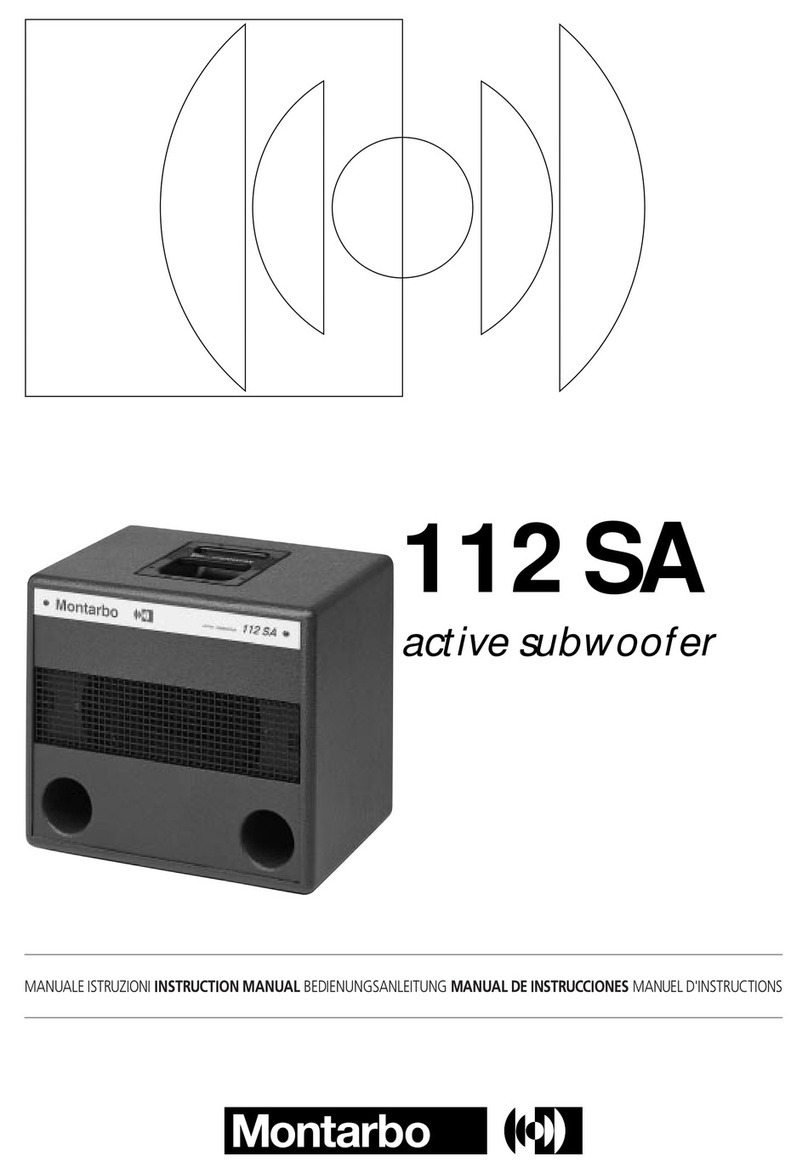
Montarbo
Montarbo 112 SA User manual

Montarbo
Montarbo 218 SA User manual
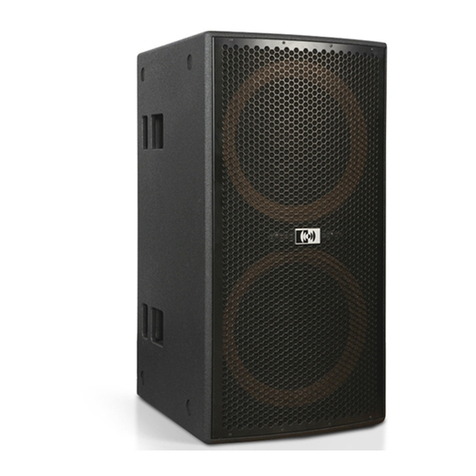
Montarbo
Montarbo EARTH 218 User manual
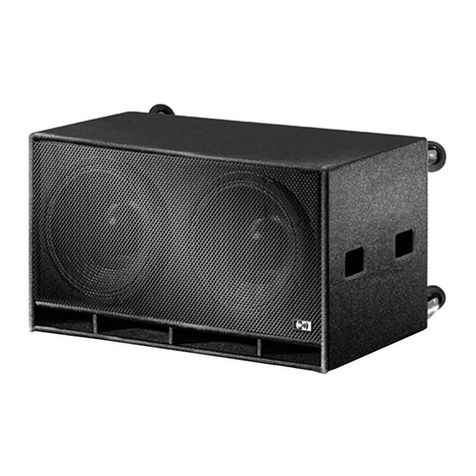
Montarbo
Montarbo BX182A Instruction manual
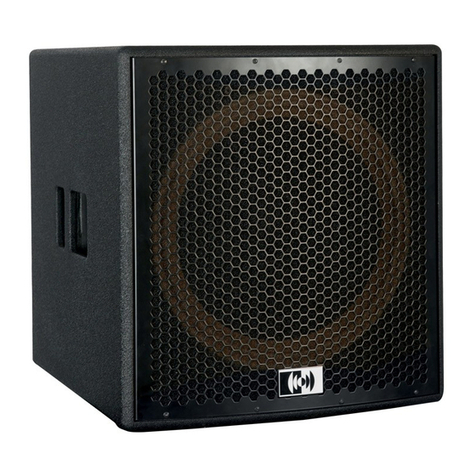
Montarbo
Montarbo Earth 118 User manual
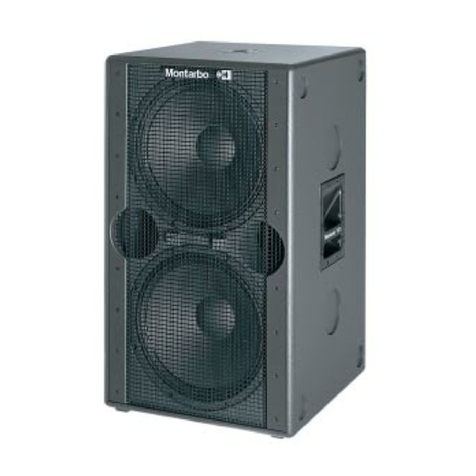
Montarbo
Montarbo 215 SA User manual
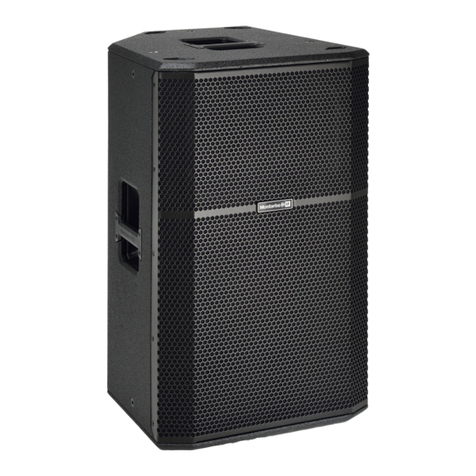
Montarbo
Montarbo R Series User manual
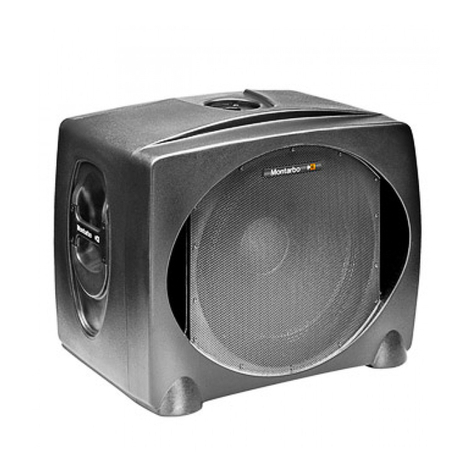
Montarbo
Montarbo SW 540 User manual

